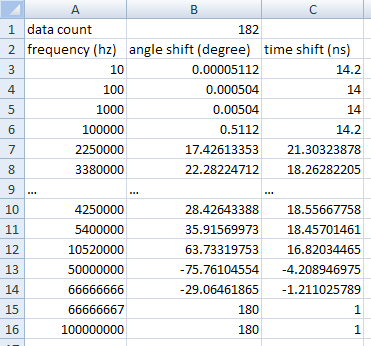
Phase Profile Concept and File Format
Phase Profile File is a csv formatted file storing phase deviations (lag) of Output Signal compared to Synch Signal. It acts as a lookup table for Goltek Controller to compensate for In-Phase Signal. A brief explanation on how its done is discussed in Stable Synchronization and In-Synch Signal. Let's look at what's inside... This is how its looks like in Ms Excel (figure below). The first line showing how many data available, i've deleted some of them for simplicity, originally there should be 182 data (row). The second line is just labeling to show what's in each column stand for. Our data start at 3rd line, there's 3 column in each data, ie frequency, phase lag (in degree) and timing lag (in nano seconds), at the time of this writing, the 3rd column is not implemented and will be ignored. We only look at the 1st 2 column, ie frequency and its phase lag (angle shift).

Each frequency will have its own phase lag, the greater the frequency, the greater the lag (angle in degree). From a rough study, Hantek Signal is lagging roughly at consistent time of around 14-20 ns regardless of frequency, but in term of angle, it will translates to different value at different frequency, ie angle = 360° * dt * freq, or angle = 360° * (dt / period), where period = 1 / freq, dt = time lag and angle in unit degree. For example, at frequency 10 Hz, with time lag of 14.2 ns, it will translate to phase lag of (360° * 14.2x10-9 ns * 10Hz) = 5.112 x 10-5, or barely 0°. but at around 10MHz, 14.2 ns time delay will translate to 51.12°. where from the table (10.52MHz), its empirically found that the delay is 16.82 ns eqv. to 63.7° (360° x 16.82 x 10-9 x 10.52 x 106). So pretty much that's about it.
As discussed in Stable Synchronization and In-Synch Signal. Goltek Controller will use this value to calculate Data Shifting for In-Phase compensation. When we set the software to output 10MHz of frequency (and Stable Synch feature ON), Goltek will look into the table and read 63° as the phase lag and calculate how much data shifting need to be done, the formula is generally written as [number of shift = (Lag / 360) * number of wave points in 1 cycle]. That's it, simple! but how do we get the value for the phase lag at various frequencies? because as we should aware, if we put wrong phase lag in the Profile File, the software will calculate the shift wrongly and hence wrong or not In-Phase signal (GIGO = Garbage In - Garbage Out).
Well, the answer is we need to profile our device (on our own), how? we send an uncompensated (Stable Synch OFF) signal (no shifting data) from PC software (Goltek Controller) to the Hantek and visually look at how much the signal is lagging in DSO and start tabulating the Profile File, easy isn't it? well it depends on how much data/frequency you want to profile, the more data, the more time required to do the profiling job. At the time of this writing, i've not develop the Goltek Profiler yet (and Goltek Compensator) that suppose to do this job easily, so the only method we have right now is to manually profile our device and manually edit the Profile File according to the format in the figure above. In the Goltek App Folder (\profile), i've included my Phase Profile File (phase3x25.csv) that i've made earlier using my simple tool. I've made the file as default phase profile for Goltek Controller the first time its loaded. Its good enough for me and i hope its good enough for you as well. In case you need more accurate phase profile, you can manually edit that file to suit your need (1st and 2nd column) or copy/rename it to another file, but you need to leave (edit) the format intact, ie the label, data count at cell B1 (above figure), data start from line 3, and 3 columns each line (even though the last column is ignored). And it only accept US style of csv, ie comma "," as separator and dot "." as decimal point. And please note, since i've made the phase3x25.csv file using another tool (engine), it may be slightly off when used in Goltek Controller which is based on newer generator engine. But so far from my observation, its pretty close. To disable this phase compensation/correction process, you can simply turn the Stable Synch feature OFF.
I think That's It!
any comment, improvement
and suggestion,
please contact me at soasystem@yahoo.com
well, too sad if you don't have a back button